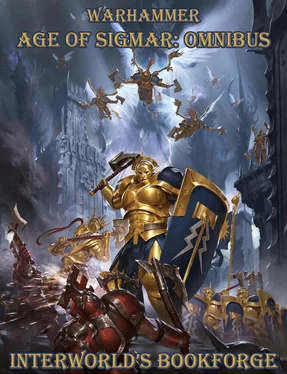The Chaos warriors howl in rage as I start to fade from sight.
It’s autumn, as the necromancer likes it, and as my boots sink deep into a mulch of muddy brown leaves I can’t help feeling a little impressed by what he has achieved. The Dark Gods have left their mark everywhere but here. Not a single brass tower mars the sombre beauty of his estates. The valley is lined only with leafless, rain-lashed trees and long, grasping shadows. The necromancer is ancient beyond even my understanding, more of a relic than the trinkets he collects, but despite everything that passed between us, I can’t deny that his learning has served him well. He claimed once that he was born in another age, long before the coming of Chaos. Such talk no longer seems quite so fanciful. Few have the power to mask themselves so completely that even a god cannot discover their presence. I never learned to pronounce my master’s true name, but the appellation I always gave him still seems apt: Mopus.
The fane itself was one of Mopus’ earliest finds. It’s the grandest of his homes and it squats at the end of the valley, as though ready to scuttle away; a crumbling mountain of faceted turquoise, forty feet tall, twice as wide and carved in the likeness of a colossal deathwatch beetle. Its compound eyes watch my approach with hunger and I pick up my pace, jogging through the whirling rain.
I hurry through the gloom and realise that not all of the shapes lining the valley are trees. I stop, peer through the drizzle and realise that there are hundreds of pale figures standing in rows around me, clutching ancient spears and staring away from the fane. They’re as motionless as the trees, but a cold light flickers in their shattered skulls. I step towards the edge of the path and see that the ranks of undead continue out of sight. There must be thousands of them, an army waiting patiently for a command. They pay no attention to me, but their presence gives me pause. Mopus was never one for wars. That was our great bone of contention — the wedge that drove us apart. It seems that many things have changed in the realm of the dead. I continue on my way with even more wariness. If Mopus is still the master of this place, then he is not the man I remember.
The entrance to the fane lies between the beetle’s broken antennae at the base of its head, and as I hurry towards the door a pair of milk-eyed cadavers step from the shadows to greet me. I would expect to be remembered at this place, but I lift my hammer just in case.
Mopus’ attendants twitch, as though tugged by invisible strings, then back away into the shadows, leaving the way clear.
I climb the steps to the towering slab of turquoise that passes for a door. It’s buried beneath a robe of dead ivy and clearly hasn’t been opened for months, so I am forced to tear and pull at the knotted mass until, finally, I uncover an iron handle. The door is locked, but the handle is so rusted that one good shove breaks it free and the door screeches open. A gentle sound seeps out through the gap: a whispered tapping, the sound of tiny pebbles pouring into a tin bowl.
I glance back and see the sentries staring blankly at me. They make no move to attack so I shove the door wider and stumble inside.
I’m met by a wall of clocks and mildewed books, stacked in mounds and filling the entrance hall. The smell of damp is overwhelming and there is something tragic about the scene. The books are rotting into an inseparable mass of gilt-edged pages and sagging, broken spines. It’s like the site of a mass burial. The clocks are in just as poor condition but, by some charm of Mopus, they are all still ticking. This is the tapping I heard — so many mechanisms working at once sounds like a distant hailstorm.
Cold blue light pours through the walls and washes over the dying books, revealing how tightly packed they are. For a moment I think there is no way to proceed, but then I spot a gap near the ceiling, to the right of the passageway. Time spent in the fane will bear no relation to the battle at the Anvil, but I cannot allow myself to dawdle. Already I can feel the lure of Mopus’ quiet cold, and I doubt the God-King would offer me a second chance at salvation.
I clamber up the wall of books and clocks, wincing at every torn cover, and reach the ceiling. The gap is too small but the air is so damp that I can shove my hammer through the barrier as though it were a bank of mud. After a few moments I manage to haul myself through the hole.
On the other side there are more piles of sodden books and broken timepieces, but I am able to crawl across them, just inches below the ceiling, until I reach the lintel of a wide doorway. I squeeze myself through the gap and into another room.
I slide down the slope of books but there’s still no sign of a floor. In this chamber, as well as more books, there are mounds of idols and fetishes. I see bronze, dog-headed statues and carved, wooden birds piled together with no obvious sense of order, but I notice that all of them carry Mopus’ tiny, handwritten labels.
It’s only as I approach another door that I notice I’m not alone. There are figures slumped amongst the relics. Some look up as I pass, but most remain intent on their work, poring over drooping pages or scratching at mouldering paintings. They’re as pale and lifeless as the monsters guarding the door, and the eyes that turn towards me are clouded and blue. Mopus has long made a habit of employing the studious dead and I start to feel more confident that my journey will not be wasted.
No one speaks so I hurry on. It’s a long time since I visited the fane, but I easily remember the way to Mopus’ chambers. If he lives, there is no question of his being absent. That much, at least, I can be sure of.
Another pair of hooded figures is watching over the entrance to his chambers, but, again, they back away at my approach, and I step through the door.
Everything is as I recall, a fact I can’t help but find comforting. Tapestries still cover every inch of the antechamber, so threadbare and thick with dust that the heroic scenes have faded into abstraction. The blurry, indistinguishable shapes, combined with the hazy, filthy air, make me feel almost drunk. That, along with the gloom, spare me from seeing most of the other things in the room. Crooked bookcases lean against much of the wall space, crammed with crumbling tomes and rows of jars. There’s enough light for me to see that the pale, half-formed shapes suspended in the jars are twitching and moving, excited by my arrival. There are countless other mysteries vying for my attention: abandoned sketches, broken pieces of scientific equipment and piles of bleached human bones, all covered with Mopus’ little labels.
I walk through into Mopus’ study and, to my surprise, the ancient scholar almost rises from his desk. He can’t quite force himself to leave his mouldering texts, but he sits in a more upright position than I have seen before, and actually turns to look at me. His face is as pallid and skull-like as ever, but his eyes flash victoriously as I approach his desk. His skin is so tightly stretched around his skull that it seems to shine in the candlelight. Every inch of him is tattooed with intricate, cabalistic designs — spidery blue wards of protection that enable to him to converse with even the most dangerous spirits. His gaunt face conjures up memories of our final fierce argument, but I can’t help feeling a little pleased to see that, amongst all this death, Mopus is still clinging to life.
I notice other figures loitering in the darkest corners of the room — ephemeral wraiths, draped in robes of pale mist, and newcomers to the fane. They drift a few feet above the dusty floorboards and I can see at a glance that Mopus has dragged them from the grave. The candlelight refuses to illuminate them fully, but I sense them staring at me with interest.
Читать дальше












